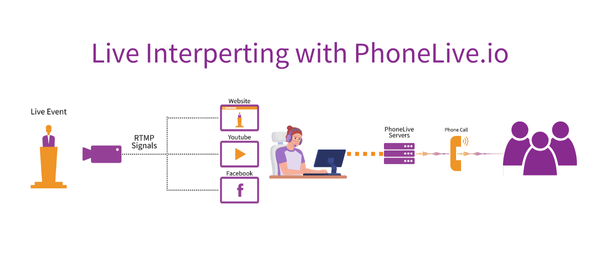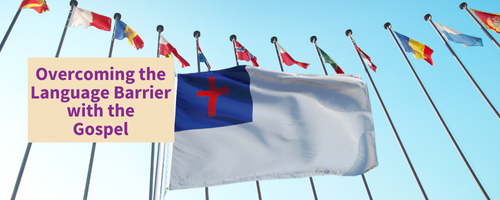Ministering in a Multicultural Community with Translation Devices
Churches desire to reach their multicultural community a prioriy, but find searching for translation equipment an overwhelming challenge.
In the United States, over 33.5 million foreign-born immigrants have made their homes. More than 17 percent of Americans speak a language other than English at home (1). This multiculturalism should be reflected in our churches, where we strive to create a welcoming environment for everyone by translating our worship services. But what happens when language becomes a barrier?
Take “Jay,” for example. Jay is a young primary from a great Christian family who loves our Sunday School class. However, he often feels left out because he doesn’t understand English very well and receives little value from attending. In addition to the limits we put on reaching our city, spiritual growth and community are stunted. This is a common scenario in many churches across the country, as multicultural communities continue to grow.
Many ministers have turned to Google to attempt to find the right church translation system to only learn everyone had their own variation they want to sell you making it hard to review the pros and cons and what was right for their own needs.
There are many translation devices available on the market, each with its own set of features and unique use cases. These devices come in a wild price range and use various technologies, including digital, FM, and Infrared. However, finding the needed staff and building the custom interfaces for the various technologies needed for a complete solution can be a daunting task, especially when dealing with facilities that interfere with the devices’ signal.
Some churches might consider holding separate services in different languages. However, this solution can lead to segregation within the church community and doesn’t promote unity.
Translation vs Interpretation
When it comes to breaking down language barriers, it’s important to understand the difference between translation and interpretation. Translation involves converting written text from one language to another, while interpretation deals with spoken language.
There are two types of interpretation: consecutive and simultaneous. In consecutive interpretation, the speaker pauses after each sentence or phrase to allow the interpreter to translate. In simultaneous interpretation, the interpreter translates the speaker’s words in real time. The native language used in your ministry is often referred to as the “floor language.”
Goals for Simultaneous Interpreter Equipment
The goal in selecting the right translation equipment for churches is to increasing your local reach, and overcome evangelism boundaries holding back key people groups.
While making sure your multiculture ministry is effective you will not want it to consume your resources. Your staff should be able to integrate the translation equipment in a timely manner while holding down the cost of operations and maintaining it.
Challenges of Using Translation Equipment for Churches
While translation translation equipment for churches can be a useful, they come with their own set of challenges. These include finding a qualified translator, finding technical volunteers to operate the equipment, and locking up funds in extra equipment needed for larger events like Easter, Christmas, or a special conference.
Distributing the equipment can also be a logistical challenge, as can cleaning and maintaining the equipment after each use.
One of the biggest challenges is that using translation headphones can limit the reach of your online stream. This is because the interpretation is only available to those who are physically present at the service.
The Power of the PhoneLive.io as a Translation Solution
Calvary Church in Charlotte, NC has found that PhoneLive.io offers a powerful solution to these challenges. They translate their Sunday services in Chinese, Russian, and Spanish serving about 150 of their members as a part of their overall international ministry (2).
With PhoneLive.io, you can offer interpretation both in-person and online. You can use a local or remote translator, depending on your needs. In addition to in-person and online translation you can use our service for multiple use cases to serve the non-English member, including replaying archived services, posting to a podcast, sending out announcements, providing prayer lines, and streaming to their blind members.
Beyond providing a translation channel, you will have a complete report on who used the service and when they used it. You will own your own “subscription” list and can call back anyone using the service.
This service is provided over the telephone and works with everyone’s phone without installing an app. PhoneLIve.io is a top translation equipment for churches.
How PhoneLive.io Simultaneous Interpretation Works

To do an interpretation of your worship service you would…
- Have an interpreter in your live service or watch your service online remotely.
- They would need a device (PC, tablet, or phone) that had a good mic attached.
- The interpreter would log into PhoneLive.io.
- They would press the “Go Live” button and start speaking.
- When they are finished, they press the “Hang Up” button.
The members who need the translation would….
- Watch your live stream if they have the means and turn down the volume.
- Receive a phone call (if they subscribed) or call the church’s toll-free number (provided by PhoneLive.io at no cost).
- They would hear the interpretation in their native language. There are no menus to navigate or access codes needed.
- There are no costs for the listeners and no app to install.
In conclusion, PhoneLive.io is a versatile technology that can serve many ministries. It simplifies the process of offering interpretation services, making it easier for churches to minister in a multicultural community. To learn more visit: https://phonelive.io/
Resources
Live-Streaming Translation, Part 1: WHY You Should Translate Your Videos, https://www.youtube.com/watch?v=INEpwqiWZgQ Developing an International Ministry, https://www.theupstreamcollective.org/post/developing-an-international-ministry
Footnotes
Breaking the Language Barrier and the Trend by Erik Tryggestad, 5/7/2007, https://christianchronicle.org/breaking-the-language-barrier-and-the-trend/, accessed 6/27/24 Calvary Church International Ministry page https://www.calvarychurch.com/internationals, accessed 6/27/24
